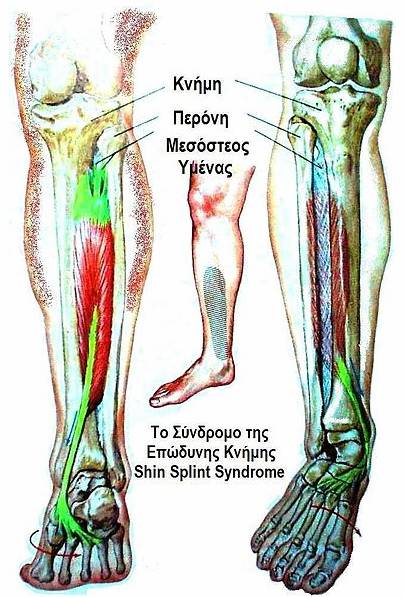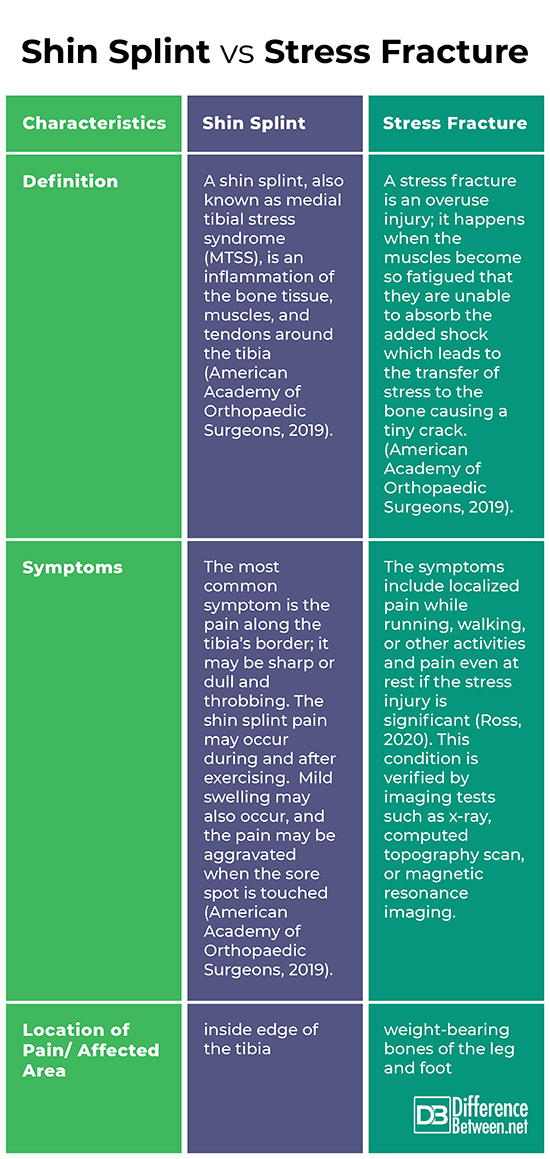Difference Between Shin Splint and Stress Fracture
Shin splints and stress fractures may both involve leg pain and difficulty in running or related activities. They may also be caused by intense physical activities and may be treated by rest, anti-inflammatory medications, and pain-free exercises. Regarding their differences, a shin splint is an inflammation of the bone tissue, muscles, and tendons around the tibia. In comparison, a stress fracture is an overuse injury; it happens when the muscles become so fatigued that they are unable to absorb the added shock which leads to the transfer of stress to the bone causing a tiny crack. The following discussions delve deeper into their distinctions.

What is a Shin Splint?
A shin splint, also known as medial tibial stress syndrome (MTSS), is an inflammation of the bone tissue, muscles, and tendons around the tibia (also known as shinbone, the long bone located in the lower leg). The pain usually occurs on the inside edge of the tibia, where muscles attach to the bone. The most common symptom is the pain along the tibia’s border; it may be sharp or dull and throbbing. The shin splint pain may occur during and after exercising. Mild swelling may also occur, and the pain may be aggravated when the sore spot is touched (American Academy of Orthopaedic Surgeons, 2019).
Causes
Shin splints are common among new runners and those who have rapidly increased their training intensity (Ross, 2020). They typically occur after abrupt shifts in physical activity. Generally, shin splints are caused by overworked leg muscle and tissue due to repetitive activity. Risk factors include having flat feet or having abnormally rigid arches. Moreover, runners, dancers, and military recruits have been frequently diagnosed with shin splints (American Academy of Orthopaedic Surgeons, 2019).
Treatment
The treatment may be started with having enough rest, using cold packs, and taking anti-inflammatory medication for the pain. This may then be followed by non-painful stretching and low-impact activities (i.e., swimming, walking, etc.). To prevent recurrence, flexibility exercises and strength training are recommended (Ross, 2020).
Moreover, wearing elastic compression bandage pay prevent swelling, shoes with good cushioning may help reduce stress on shins, and orthotics (supportive shoe inserts) may help in stabilizing the foot and ankle. In extremely rare cases, surgery has been done to patients who did not respond to nonsurgical treatment (American Academy of Orthopaedic Surgeons, 2019).

What is Stress Fracture?
A stress fracture is an overuse injury; it happens when the muscles become so fatigued that they are unable to absorb the added shock which leads to the transfer of stress to the bone causing a tiny crack. It is one of the most common sports injuries. More than 50% of cases occur in the lower leg; the weight-bearing bones of the leg and foot are highly vulnerable to stress fractures. This condition is verified by imaging tests such as x-ray, computed topography scan, or magnetic resonance imaging (American Academy of Orthopaedic Surgeons, 2019). The symptoms include localized pain while running, walking, or other activities and pain even at rest if the stress injury is significant (Ross, 2020).
Causes
The causes of stress fracture include rapidly increasing the intensity or amount of an activity, impact of unfamiliar surfaces (i.e., shifting from a soft clay court to a hard court), and improper equipment such as using worn out shoes (American Academy of Orthopaedic Surgeons, 2019).
Treatments
The treatments include rest, anti-inflammatory medication, returning to pain-free activities after several weeks, and proper diet with calcium and vitamin D supplements for bone health (Ross, 2020). It usually takes 6-8 weeks for the stress fractures to heal and shoe inserts or braces may be helpful (American Academy of Orthopaedic Surgeons, 2019). Surgery is rarely needed and is only recommended when nonsurgical treatments have not worked (Ellis, 2019).
Difference between Shin Splint and Stress Fracture
Definition
A shin splint, also known as medial tibial stress syndrome (MTSS), is an inflammation of the bone tissue, muscles, and tendons around the tibia, which is also known as shinbone, the long bone located in the lower leg. On the other hand, a stress fracture is an overuse injury; it happens when the muscles become so fatigued that they are unable to absorb the added shock which leads to the transfer of stress to the bone causing a tiny crack. It is one of the most common sports injuries (American Academy of Orthopaedic Surgeons, 2019).
Symptoms
The most common symptom of shin splint is the pain along the tibia’s border; it may be sharp or dull and throbbing. The shin splint pain may occur during and after exercising. Mild swelling may also occur, and the pain may be aggravated when the sore spot is touched (American Academy of Orthopaedic Surgeons, 2019). As for stress fracture, the symptoms include localized pain while running, walking, or other activities and pain even at rest if the stress injury is significant (Ross, 2020). This condition is verified by imaging tests such as x-ray, computed topography scan, or magnetic resonance imaging.
Location of Pain/ Affected Area
The shin splint pain usually occurs on the inside edge of the tibia, where muscles attach to the bone. In comparison, more than 50% of stress fracture cases occur in the lower leg; the weight-bearing bones of the leg and foot are highly vulnerable to stress fractures.
Shin Splint vs Stress Fracture

Summary
- A shin splint is an inflammation of the bone tissue, muscles, and tendons around the shinbone
- A stress fracture is an overuse injury; it happens when the muscles become so fatigued that they are unable to absorb the added shock which leads to the transfer of stress to the bone causing a tiny crack.
- The shin splint pain usually occurs on the inside edge of the tibia while the weight-bearing bones of the leg and foot are highly vulnerable to stress fractures.
- Difference Between Hematoma and Melanoma - February 9, 2023
- Difference Between Bruising and Necrosis - February 8, 2023
- Difference Between Brain Hematoma and Brain Hemorrhage - February 8, 2023
Search DifferenceBetween.net :
Leave a Response
References :
[0]American Academy of Orthopaedic Surgeons. (2019). Shin splints. https://orthoinfo.aaos.org/en/diseases--conditions/shin-splints#:~:text=Shin%20splints%20(medial%20tibial%20stress,of%20your%20tibia%20(shinbone).
[1]Ellis, S. (2019). Stress fractures of the foot and ankle. HSS. https://www.hss.edu/conditions_stress-fractures-foot-ankle.asp
[2]Ross, B. (2020). Stress fracture or shin splints? UChicago Medicine https://www.uchicagomedicine.org/forefront/orthopaedics-articles/stress-fracture-or-shin-splints#:~:text=The%20lower%20leg%20pain%20of,lower%20leg%2C%20hip%20or%20foot.
[3]Image credit: https://live.staticflickr.com/6112/6395528753_c915d04835_b.jpg
[4]Image credit: https://commons.wikimedia.org/wiki/File:Shin_Splint_Syndrome.jpg
